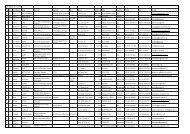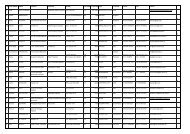icvg 2009 part I pp 1-131.pdf - Cornell University
icvg 2009 part I pp 1-131.pdf - Cornell University
icvg 2009 part I pp 1-131.pdf - Cornell University
You also want an ePaper? Increase the reach of your titles
YUMPU automatically turns print PDFs into web optimized ePapers that Google loves.
— 29 —<br />
NEW DEVELOPMENTS IN UNDERSTANDING GENE FUNCTIONS AND EVOLUTION<br />
OF THE GRAPEVINE CLOSTEROVIRUSES<br />
Valerian V. DOLJA<br />
De<strong>part</strong>ment of Botany and Plant Pathology and Center for Genome Research and Biocomputing, Oregon State <strong>University</strong>,<br />
Cordley Hall 2082, CORVALLIS, OR 97331, USA<br />
Telephone: +1-541-737-5472; Fax: +1-541-737-3573; E-mail address: doljav@science.oregonstate.edu<br />
Summary<br />
There are ~10 viruses from the family Closteroviridae<br />
associated with the grapevine leafroll disease (GLRD). Among<br />
these, Grapevine leafroll-associated virus-2 (GLRaV-2) is a<br />
member of the Closterovirus genus, whereas the remaining viruses<br />
belong to the genus Ampelovirus. Recent work has resulted in<br />
characterization of a novel GLRD-related ampelovirus with<br />
unusually short genome. On the other hand, bioinformatics<br />
analysis demonstrated that the limited nucleotide sequence that<br />
reportedly belonged to GLRaV-8 was actually derived from the<br />
grapevine genome. Availability of the biologically active cDNA<br />
clone of GLRaV-2 allowed functional characterization of the<br />
genes encoding two leader proteases. In addition, it was shown<br />
that the AlkB domains found in many diverse plant viruses<br />
including grapevine ampeloviruses, function in repairing RNA<br />
damage by oxidative demethylation. Future progress in<br />
understanding GLRD-associated viruses and using them as the<br />
tools of grapevine biotechnology will depend on broader<br />
a<strong>pp</strong>lication of the high-throughput sequencing, generation of the<br />
full-length cDNA clones for ampeloviruses and, most pressingly,<br />
on the development of the efficient technique for grapevine<br />
inoculation with the genetically modified viruses.<br />
NOVEL LEAFROLL-ASSOCIATED<br />
AMPELOVIRUSES FROM GREECE<br />
Recent analysis of the Greek grape varieties<br />
Prevezaniko and Debina revealed two GLRD-associated<br />
virus isolates, GLRaV-Pr and –De, of which at least the<br />
former presents a novel ampelovirus (Maliogka et al.,<br />
<strong>2009</strong>). Given that, among other things, ancient Greece was<br />
known for large production and avid consumption of wine,<br />
the chances are that these are the antique viruses, and<br />
comparative genomic and phylogenetic analyses seem to<br />
concur with this notion (Maliogka et al., 2008; Maliogka et<br />
al., <strong>2009</strong>). By Closteroviridae family standards, GLRaV-Pr<br />
has the unusually small genome stri<strong>pp</strong>ed to the bare<br />
essentials, that is, the conserved replication and quintuple<br />
virion assembly/transport gene blocks. It is not even clear if<br />
the latter actually includes a minor capsid protein or CPm;<br />
due to marginal similarity to the major CP, the gene<br />
occupying CPm position could encode either an extremely<br />
divergent or even unrelated protein. An additional<br />
experimental analysis is required to solve this intriguing<br />
issue.<br />
Uncannily, the GLRaV-Pr genome looks exactly as<br />
has been proposed for a common ancestor of the<br />
ampelovirus genus that is just one step a<strong>part</strong> from such<br />
ancestor of the entire family Closteroviridae (Dolja et al.,<br />
2006). From an evolutionary prospective, however, smallest<br />
and simplest does not necessarily imply the most ancient<br />
origin. The secondary process of genome reduction typical<br />
of parasitic organisms is also a viable possibility<br />
compatible with the ‘retired’ life style of many grapevine<br />
viruses that survive for up to a century in the same vine and<br />
are transmitted predominantly via grafting.<br />
THE UNTIMELY DECREASE OF GLRaV-8<br />
Ironically, addition of GLRaV-Pr to the list of<br />
currently recognized viruses related to GLRD did not<br />
change the grand total because it became exceedingly clear<br />
that the rumors of the existence for one of these viruses,<br />
GLRaV-8, have been greatly exaggerated. A<br />
straightforward BLAST analysis using the only available,<br />
allegedly GLRaV-8-derived, sequence yielded no hits to<br />
any viral sequences, leave alone closteroviruses (V. Dolja<br />
& S. Bertsch, unpublished data). Furthermore, two<br />
completely sequenced Vitis vinifera genomes each<br />
contained the exact replica of the sequence in question. The<br />
latter fact demonstrated unequivocally that the reported<br />
‘GLRaV-8 sequence’ was nothing more than a cloning<br />
artifact. Therefore, GLRaV-8 must be taken off the list,<br />
moreover, utilization of the number 8 for another, even if<br />
more real, GLRaV, would hardly be advisable.<br />
FUNCTIONS OF THE GLRaV-2 TANDEM LEADER<br />
PROTEASES<br />
Generation of the infectious cDNA clones of GLRaV-<br />
2 tagged via insertion of GFP, enzymatic, and epitope<br />
reporters provided critical tools for addressing GLRaV-2<br />
gene functions (Liu et al., <strong>2009</strong>). Because most of GLRaV-<br />
2 genes have orthologs in well-characterized Beet yellows<br />
virus (BYV), the work was focused on a tandem of papainlike<br />
leader proteases (L1 and L2) present in GLRaV-2 and<br />
some other closteroviruses, but not in BYV that has only<br />
one such protease. Although gene swa<strong>pp</strong>ing experiments<br />
suggested synergistic mode of action for tandem proteases<br />
(Peng et al., 2001), their functional profiles remained<br />
largely uncharacterized. The roles of L1 and L2 in RNA<br />
accumulation were addressed using tagged GLRaV-2<br />
minireplicons and agro-infiltration of an experimental host<br />
plant Nicotiana benthamiana. It was found that the deletion<br />
of genome region encoding the entire L1-L2 tandem<br />
resulted in a ~100-fold reduction in minireplicon RNA<br />
accumulation. Five-fold reduction in RNA level was<br />
observed upon deletion of L1 coding region. In contrast,<br />
deletion of L2 coding region did not affect RNA<br />
accumulation. It was also found that the autocatalytic<br />
cleavage by L2 but not by L1 is essential for genome<br />
replication. Analysis of the corresponding mutants in the<br />
Progrès Agricole et Viticole, <strong>2009</strong>, Hors Série – Extended abstracts 16 th Meeting of ICVG, Dijon, France, 31 Aug – 4 Sept <strong>2009</strong>




